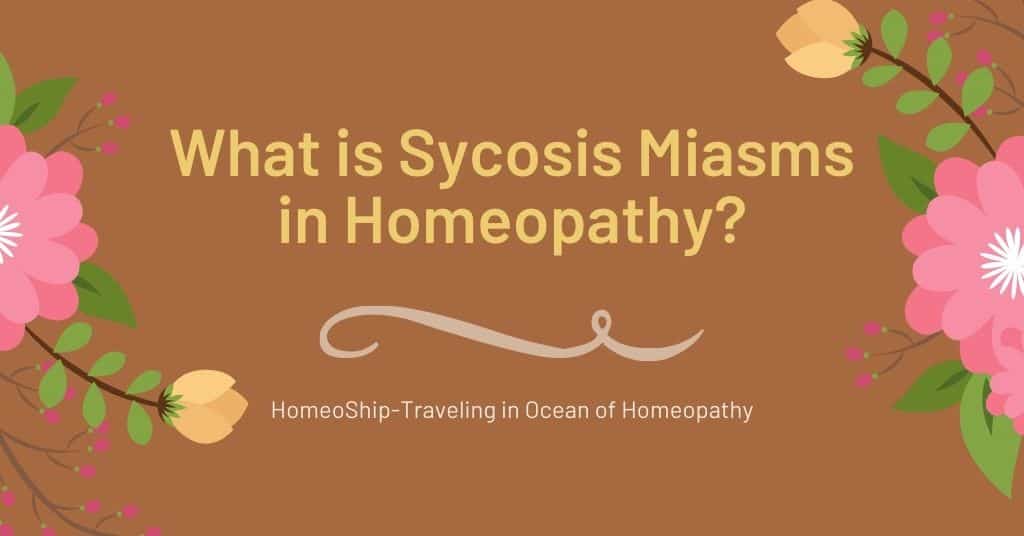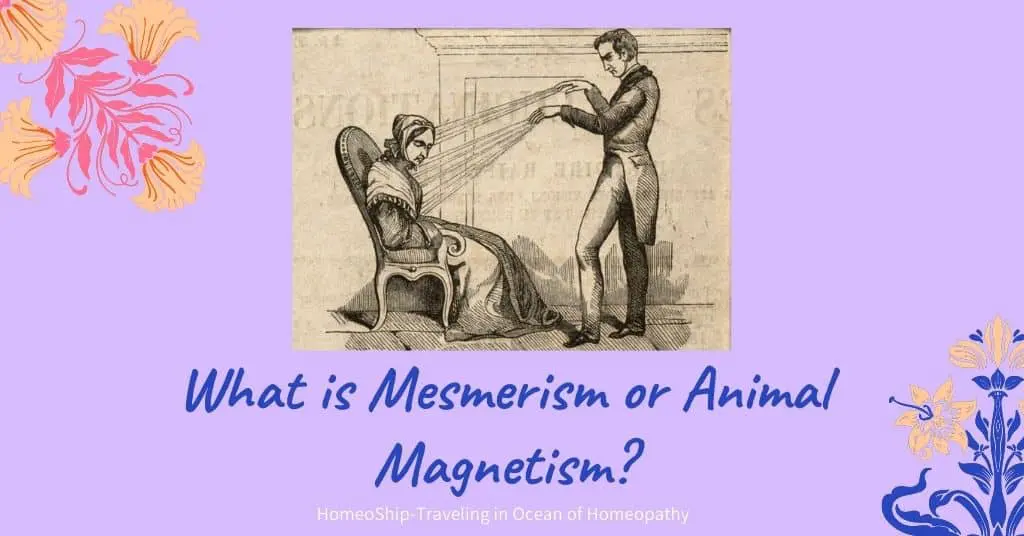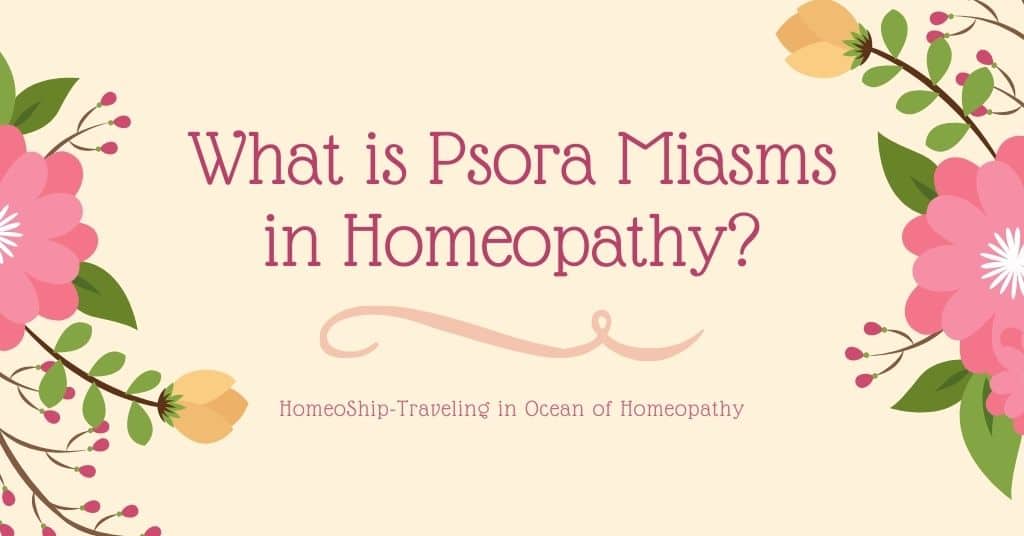Contents
Sycotic or Sycosis miasm is also called the “figwarts disease”, is a chronic venereal miasmatic disease. This is developed as a result of suppressed gonorrhea. The main external manifestations of sycosis are cauliflower or coxcomb-like warts on the skin. Hence it is called by Hahnemann as figwarts disease.

Development of Sycosis Like any other miasmatic disease, sycosis develops in the 3 following steps:
1. Mode of infection
2. Internal development
3. External manifestations: i. Primary manifestations ii. Secondary manifestations
1. Mode of infection
Impure coition, most probably at the very movement in the spot, which is touched and rubbed, the specific contagion has arisen. “To effect the infection it requires a certain amount of friction in the most tender parts of the body (sexual organs), which are most rich in nerves and covered with thinnest cuticle.” The infection mostly occurs in the genital organs, especially at the wounded spot. Hence, the sycotic miasm just like syphilitic miasm is called the venereal miasm.
2. Internal development
As soon as the sycotic miasm touches the spot infected, in the same moment it is no more local. The whole body has already received its presence immediately in a dynamic manner. “All wiping and washing off the spots affected, however speedy and with whatever fluid, is too late and in vain”. During the first few days, no morbid sign appears in the spot affected. Only after the internal venereal transmission is completed fully, the primary manifestations develop in the place first affected. This is intended by the nature to sooth (truth) the internally completed malady.
3. External manifestations
i. Development of primary manifestations of sycosis:
Once the dynamic internal development of the sycotic miasm is over, the local symptoms develop. These excrescences are usually but not always attended by gonorrhea, a thick pus-like discharge from the urethra. This might be followed by a less difficult micturition, somewhat hard, the swollen body of penis in males. Sometimes the body of the penis is also covered with black, glandular tubercles that are very painful to touch.
These symptoms will develop several days or several weeks, even many weeks after infection through impure coition. Very rarely dry, wart-like, soft, spongy growth emitting a specifically fetid fluid, sweetish and almost like herring brine, bleeding easily and in the form of Coxcomb or a cauliflower-like growth can also occur. In males, these can be seen on the glans or below it, or on the prepuce. But in females, these can be seen on the parts surrounding the pudenda or on the pudenda itself. These can even occur in swollen and in great numbers. These are the primary manifestations of sycosis.
ii. Development of the secondary manifestations of sycosis:
The primary manifestations of sycosis like warts, coxcomb, or cauliflower-like growths on genitals are treated by allopaths in the most violent external cauterization, burning, and cutting or by ligature. In such cases, nature again produces such growths to sooth (truth) the internal development of sycosis.
But again, when such violent procedures like cauterization, burning, cutting, or ligature are employed, the figwarts disease, after being deprived of its local complaints, continues to develop internally and appears in a much worse way in secondary ailments.
Non-Penetrating Variety (Common Gonorrhea) of Sycosis, in the footnote to the explanation of sycosis in his book “Chronic disease”, Hahnemann identifies another type of gonorrheal miasm.
“The miasm of the other common gonorrhea seems not to penetrate the whole organism, but only to locally stimulate the urinary organs.”
Such another type of gonorrhea does not penetrate the organism dynamically but only produces local inflammation and frequent urging to urinate. Hahnemann recommends in such cases, only the acute acting remedies like Petroselinum, Cantharis, Copaiva balm, etc based on the patient’s symptomatology.
Kent’s Views On Sycosis: Lecture No. XXI

According to Dr. J.T. Kent, there are two types of urethral infections. The first one is simple urethral inflammation, which is not contagious. The second is specific urethral inflammation, which is always contagious. The specific urethral infection can be termed as the true gonorrhoeal inflammation.
This true gonorrhoeal inflammation according to Kent, is again of two types, the acute and the chronic varieties. The acute specific urethral inflammation is caused by acute miasm and has a period of prodrome, a period of progress, and a period of decline. But the sycotic constitutional symptom does not follow the suppression of this acute miasm.
This means acute specific urethral inflammation does not develop into a chronic sycotic state. If suppressive treatment is to be restored to acute, the system is sufficiently vigorous in most cases to throw off the after-effects. The acute specific type is contagious.
The chronic specific type also has the same prodromal period of 8 to 12 days as the acute specific type. But when suppressed, the chronic type will develop into a sycotic miasmatic state. Remedies for each sycotic type have to be selected in the same way as any other miasmatic disease i.e. by anamnesis, based on the totality of symptoms and individualization. Anti-sycotic medicine is one which when administered based on symptom similarity, can turn the progress of the disease backward.
For example, it is often the case that a man with thick, yellowish-green discharge from the nose, after a dose of Calcarea, which is an anti-sycotic, the deepest in character, has his old discharge brought back. This is the curative process of anti-sycotic remedies. It brings out the suppressed disease. The sycotic patient infects his partner only in that stage of the disease in which he is currently suffering.
For example: at the time of marriage if the husband is having primary manifestations of sycosis, he will infect his innocent wife with the primary manifestations only. On the contrary, if he is suffering from secondary manifestations (which are very difficult to diagnose), he infects the secondary manifestations to his better half.
Must Read all other Maisms
- What is Psora Miasm in Homeopathy?
- What is Syphilis Miasm in Homeopathy?
- What are the causes for disease in homeopathy?
Treatment Of Sycosis

Before treating any case of urethral discharge, the case has to be studied under two headings. Whether the sycosis to be treated is of a penetrating type or non-penetrating type? Hahnemann recognizes the non-penetrating type of common gonorrhea, which is not having the capacity to penetrate the whole organism.
Hence, this type of gonorrhea cannot develop into a fully developed sycotic miasmatic state. This, he mentions in a footnote to the explanation of the treatment of sycosis in his book “Chronic diseases”.
Treatment of the Non-Penetrating type of Gonorrhea
(Ref: footnote to the treatment of sycosis in the book “Chronic diseases”)
Hahnemann recognizes a common type of gonorrhea which seems not to penetrate the whole organism. This miasm yields to a dose of highly dynamized parsley juice (Petrosolium), or Cannabis, or Cantharides, or the Copaiva balm.
But, the final medicine has to be chosen on the basis of the constitutional symptoms. Even in such cases, if slumbering psora is awakened by the harmful allopathic treatment, the case can only be cured by anti-psoric treatment.
Treatment of the Penetrating Type of Gonorrhea
or
Treatment of the Sycotic Miasm Proper
1. When the sycosis remains with all its excrescences on the skin:
i. When the primary manifestations are still present on the local parts, unaltered by the local treatments, the sycosis can be cured surely and most thoroughly by the internal use of Thuja.
ii. The dose required is a few pellets as large as poppy seeds, moistened with Thuja dynamization.
iii. These medicines are allowed to act for 15, 20, or 40 days till their action exhausts. The repetition has to be done every time in a different potency. This method facilitates and strengthens its ability to affect the vital force.
iv. When Thuja completes its action fully, this can be altered with a small dose of Nitric acid in the dynamized form.
v. It is not necessary to use any external applications except in most difficult cases. The large fig-warts may be moistened every day with the mild, pure juice pressed from the green leaves of Thuja and mixed with equal parts of alcohol.
2. When the external excrescences are removed by local treatment but the sycotic miasm is still alone:
i. Such cases cannot be assured of perfect cure, as external excrescences which were indicating the existence of the disease, are removed. But the local area still shows discolored spots, indicating the presence of internal sycosis. In this case, the suitable anti-sycotic remedy can be selected based on the symptom totality and this medicine can be administered till the skin color changes to that of the normal surrounding skin.
ii. Then it must be followed by anti-psoric treatment to assure a perfect cure.
3. When the suppressed sycosis is complicated with developed psora alone:
i. An allopath treats a case of gonorrhea and its excrescences with violent measures like cauterization, desiccations, etc. Such allopathic non-healing art awakens the slumbering latent psora and complicates it with the recently suppressed sycosis.
ii. This condition has to be treated with anti-psoric treatment first, which has to be followed till the developed psora recedes back to its latent form again.
iii. The visible sycotic symptoms now can be treated with a suitable antipsychotic treatment.
iv. Once again the anti-psoric treatment has to be continued.
v. Thus, the anti-psoric and the anti-sycotic treatments can be administered alternatively and can be repeated several times till it gets fully cured.
4. When the suppressed sycosis complicates with the developed psora and developed syphilis:
i. This threefold complicated disease (sycosis + developed psora + developed syphilis) must first be treated with anti-psoric medicines, according to the predominant psoric symptoms.
ii. The anti-sycotic and anti-syphilitic remedies can be altered one after another, the symptoms of which, are at the time the most prominent. In doing so, each remedy must be allowed to complete its action fully.
iii. To remove the remaining psoric symptoms, anti-psoric treatment can be resumed again to perfect the cure.
iv. Each one of these three kinds of anti-miasmatic remedies has to be given at a proper time and purely according to the symptom totality.
v. Such alternating treatment may be continued successively till a complete cure is achieved.



